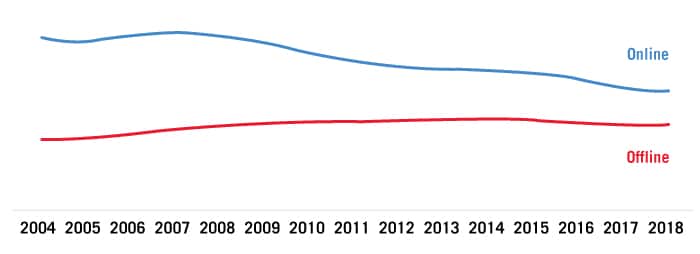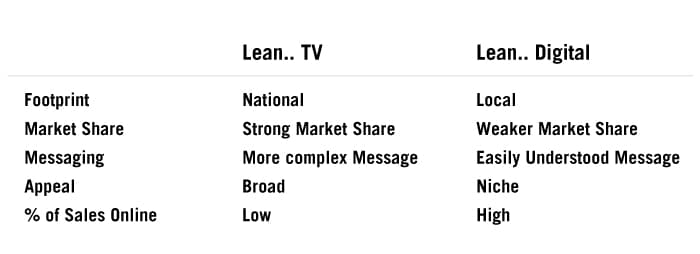When it comes to advertising, there are two important factors to consider: What is driving your business today vs. what will drive your business in the future? For most consumer businesses, TV is what has driven the largest contribution of advertising sales for a very long time. But compared to years ago, TV’s contribution to sales is shrinking. More money is being funneled into the areas that marketers believe will drive their business in the future: Instagram, Amazon, Google, retargeting, influencers etc.
Often within companies, there are two camps of people: those who believe in the power of TV for brand building and those who believe digital, social, and other more targeted tactics are the drivers of the future. The good news is, this internal tug-of-war often results in better outcomes overall. Consumers are changing, but not fast enough to cause digital media to replace TV as the best tool for reaching as many consumers as possible. TV returns tend to be more consistent and more scalable. Digital executions have higher ROIs on average, but a much wider range of performance.
Higher returns for digital advertising are a necessity today given the risks like fraud or viewability. As the digital marketplace becomes less like the Wild West and spend levels continue to increase dramatically, digital ad platforms will be happy to raise their prices. At Analytic Partners we have clearly seen these market forces at play. Below you can see how online and offline advertising efficiencies are on a path of convergence over time.
Advertising Efficiency Trends Across Industries

Source: Analytic Partners ROI Genome; Analysis based on over 3,200 campaigns from 2012-2018
Online + Offline = Success
Given the higher returns, why not go all in on digital? Unless your marketing budgets are too small to properly support TV, it is much more difficult to make the case to go all in on digital. The combined quality and reach of TV makes it a valuable tool for building long-term equity and penetration. Campaigns that have the greatest returns take advantage of synergies and leverage the vast reach of TV alongside the higher efficiency and frequency of digital.
ROI Comparison: Single Channel Strategy vs. Combined

Additionally, a multichannel campaign creates consumption synergies, enabling advertisers to capture consumer attention at different engagement points in their purchase journey. So, when it comes to a multichannel advertising campaign, the whole is worth much more than the sum of its parts. And this conclusion holds true not only in national campaigns but also globally.
ROI Index by Number by Media Platforms
Maximizing the Mix: TV vs. Digital
At Analytic Partners, we’ve assessed millions of data points to glean the following best practices for deciding when to lean in on digital vs. TV.

When it comes to the job of growing your business, both TV and digital are critical to building a holistic marketing strategy. If your marketing budgets are too small to properly support both, it may be wise to question whether the budget allocated is enough to accomplish the goals at hand. At the end of the day, digital and TV are not replacements for one another, they are two tools that work best when leveraged side by side to accomplish a shared goal: growth.





